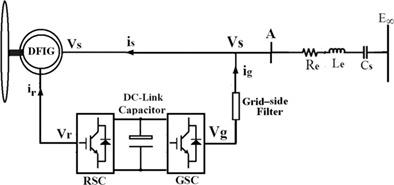当前位置:
X-MOL 学术
›
Int. Trans. Electr. Energy Syst.
›
论文详情
Our official English website, www.x-mol.net, welcomes your feedback! (Note: you will need to create a separate account there.)
Analytical assessment of subsynchronous resonance (SSR) impact on doubly fed induction generator wind turbine behavior and efficient suppression of SSR oscillations
International Transactions on Electrical Energy Systems ( IF 2.3 ) Pub Date : 2021-01-21 , DOI: 10.1002/2050-7038.12798 Amir Hossein Azizi 1 , Mohsen Rahimi 1
International Transactions on Electrical Energy Systems ( IF 2.3 ) Pub Date : 2021-01-21 , DOI: 10.1002/2050-7038.12798 Amir Hossein Azizi 1 , Mohsen Rahimi 1
Affiliation

|
Wind‐farms are usually placed in remote areas, and thus high‐voltage AC‐based transmission systems with series capacitive compensation may be cost‐effective approaches for connection of wind‐farms to the grid over long transmission lines. However, the risk of subsynchronous resonance (SSR) is the main issue raised in series compensated transmission systems. This article first analytically investigates the effect of SSR phenomenon on the doubly fed induction generator (DFIG) dynamic behavior in a series compensated grid, and then proposes a proficient damping approach for complete suppression of SSR oscillations. The proposed damping approach is created by partial/full compensation of rotor back‐emf voltages by modifying the rotor‐side converter control. It is shown that under full compensation of rotor back‐emf voltages: (a) the rotor, stator, and grid currents become independent of SSR and (b) the DFIG and rotor circuit do not contribute to the induction generator effect, and subsynchronous oscillations have vanished quickly. In this article by the modal analysis and simulation results, it is shown that the proposed approach has a satisfactory response under different values of short circuit ratio and different series compensation levels. Next, it is shown that the proposed approach has superior performance compared to the rotor virtual resistance emulation approach.
中文翻译:

次同步共振(SSR)对双馈感应发电机风力发电机性能的影响和对SSR振荡的有效抑制的分析评估
风电场通常放置在偏远地区,因此具有串联电容补偿的高压交流输电系统可能是通过长输电线将风电场连接到电网的经济有效的方法。但是,次同步谐振(SSR)的风险是串联补偿传输系统中提出的主要问题。本文首先分析研究了SSR现象对串联补偿电网中双馈感应发电机(DFIG)动态行为的影响,然后提出了一种有效的阻尼方法来完全抑制SSR振荡。通过修改转子侧变流器控制部分或完全补偿转子反电动势电压,从而创建了建议的阻尼方法。结果表明,在完全补偿转子反电动势的情况下:(a)转子,定子,电网电流变得与SSR无关,并且(b)DFIG和转子电路不会对感应发电机产生影响,并且次同步振荡很快消失了。本文通过模态分析和仿真结果表明,该方法在不同的短路比值和不同的串联补偿水平下具有令人满意的响应。接下来,表明与转子虚拟电阻仿真方法相比,该方法具有更好的性能。结果表明,所提出的方法在不同的短路比值和不同的串联补偿水平下具有令人满意的响应。接下来,表明与转子虚拟电阻仿真方法相比,该方法具有更好的性能。结果表明,所提出的方法在不同的短路比值和不同的串联补偿水平下具有令人满意的响应。接下来,表明与转子虚拟电阻仿真方法相比,该方法具有更好的性能。
更新日期:2021-03-02
中文翻译:

次同步共振(SSR)对双馈感应发电机风力发电机性能的影响和对SSR振荡的有效抑制的分析评估
风电场通常放置在偏远地区,因此具有串联电容补偿的高压交流输电系统可能是通过长输电线将风电场连接到电网的经济有效的方法。但是,次同步谐振(SSR)的风险是串联补偿传输系统中提出的主要问题。本文首先分析研究了SSR现象对串联补偿电网中双馈感应发电机(DFIG)动态行为的影响,然后提出了一种有效的阻尼方法来完全抑制SSR振荡。通过修改转子侧变流器控制部分或完全补偿转子反电动势电压,从而创建了建议的阻尼方法。结果表明,在完全补偿转子反电动势的情况下:(a)转子,定子,电网电流变得与SSR无关,并且(b)DFIG和转子电路不会对感应发电机产生影响,并且次同步振荡很快消失了。本文通过模态分析和仿真结果表明,该方法在不同的短路比值和不同的串联补偿水平下具有令人满意的响应。接下来,表明与转子虚拟电阻仿真方法相比,该方法具有更好的性能。结果表明,所提出的方法在不同的短路比值和不同的串联补偿水平下具有令人满意的响应。接下来,表明与转子虚拟电阻仿真方法相比,该方法具有更好的性能。结果表明,所提出的方法在不同的短路比值和不同的串联补偿水平下具有令人满意的响应。接下来,表明与转子虚拟电阻仿真方法相比,该方法具有更好的性能。


























 京公网安备 11010802027423号
京公网安备 11010802027423号